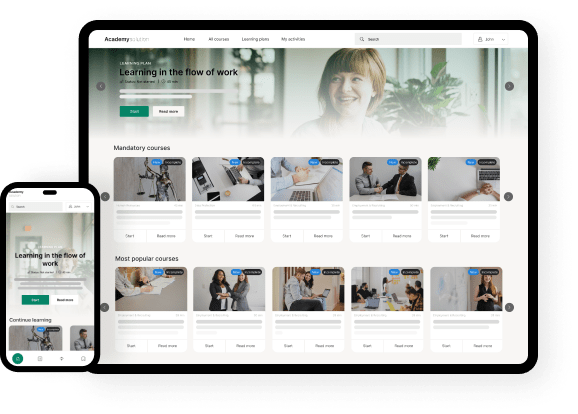Did you know that a poor onboarding experience is all it takes for your new employee to quit? Actually, 20 % of employee turnover happens in the first 45 days of a program.
If employers spend around 33 % of a worker’s annual salary to find a new replacement, just imagine how expensive it’ll be to replace twenty senior-level employees.
However, 69 % of new employees says they’re more likely to stay if their integration experience is good.
If you’d be able to keep almost three-fourths of your new employees for at least three years, then you’ll save both time and money.
So, in fact, there’s no reason not to make a big deal out of your employee onboarding. And you can’t even say you don’t know enough about onboarding. Because in the following we’ll answer the five most frequently asked questions on this matter. Furthermore, we’ll also let you in on the best practices to help you onboard new talents with optimum success.
What is onboarding?
Onboarding is a term used in the Human Resources Industry to refer to the act of acclimating new employees within an organization. An onboarding program is a set of procedures that include various integration and learning activities intended to help new employees learn more about the company, its culture, policies, and practices.
The onboarding process lasts longer than orientation. It consists of events grouped into four phases: pre-onboarding, the first day, initial development, and separation. It’s not uncommon for onboarding training to last a year or more depending on the new employees’ needs.
Orientation is only a small part of the entire training program. Orientation is a brief introduction given during the first day of onboarding. A company orientation may include introductory activities like meet and greet sessions with department heads and other co-workers. It’s also at orientation that new employees are assigned to specific work buddies, who’ll be their guide throughout their corporate journey.
Why is proper onboarding important?
When talking about the importance of having a proper onboarding process, Amy Hirsh Robinson, principal of the consulting firm The Interchange Group, has this to say:
It [onboarding] offers an imprinting window when you can make an impression that stays with new employees for the duration of their careers.
Thus, employee integration should be considered as essential as other operational processes. And so, building a successful training program should receive the same attention and urgency as marketing and sales projects are given.
Your investment in a quality acclimation system will most likely give you a guaranteed ROI. However, the rewards of your investment will go well beyond monetary figures. Because the actual value of your investment is measured in your employees’ capacity to show long-term commitment and unwavering engagement.

Source: Gallup
Is onboarding the same as training?
While onboarding and training are not the same, they exist side-by-side. To understand the correlation between these two concepts, you need to look at the bigger picture.
Onboarding is an intricate, year-long process ideally facilitated through a company’s own learning academy. The process is supposed to introduce the new employee to the ideals and objectives of the organization.
Meanwhile, the training covers all the fundamental knowledge the new employee needs in order to carry out their new tasks. This could be any learning activity that somehow explains how to complete tasks or use a platform or a piece of equipment.
What is an onboarding checklist?
An onboarding checklist is a template that highlights all the methods, compliance documents, and stages that the new employee must be involved in and fill out in order to complete the probationary training period. A new hire onboarding checklist contains the essential components of a standardized learning system. Your list can include:
- Important company documents such as tax forms, contracts, payroll records, and an employee handbook
- Meeting schedules
- Budget for subject matter experts, training materials, and other onboarding resources
- An onboarding lifecycle template to describe the employees’ recruitment journey — from pre-onboarding to their first day of work
- Survey or feedback forms
- A digital platform or e-learning solution
- Assessment tools to measure learning success
Identifying what items to add to your checklist will depend on your objectives. Yet, keep in mind you can always update your list based on the changing needs of your employees.
What is the best onboarding practice?
When the time comes, and you’ll need to expand your team, you should try out these strategies to make your onboarding program more engaging and effective.
Keep the four C’s in mind
Avoid making your new employee’s first day at their new worksite stressful and confusing. Set clear objectives to help reduce your recruit’s stress levels and keep them engaged throughout the program. In order to do so, your onboarding plan should cover the following:
Compliance
Compliance or corporate compliance sits at the lowest level of the onboarding process. It contributes to new employees learning about basic company rules and policies. And it furthermore involves them filling out all necessary onboarding documents.
Culture
Every company has its own culture, norms, and values, which every employee needs to know and (preferably) embrace. Explaining recruits how they complement and impact your company adds to your new employees feeling welcome and included.
Clarification
New employees need to understand their roles and responsibilities in order to determine how they can contribute to a given project. Clarifying the nature and scope of their position gives them the confidence to complete and deliver tasks.
Connection
The acclimation stage is where healthy working relationships should develop. The early phase of your employees’ integration journey serves as the perfect time to build connections and break barriers. There are various ways to encourage new talents to connect with their co-workers. One example would be through a buddy system.
Focus on collaboration
There’s nothing fancy about the term collaborative onboarding. It’s just one way of describing the method of breaking and sharing the tasks across all company tiers; from the executive leadership board to the new hire.
It might not be a new concept, but there’s beauty in collaboration – especially when it comes to onboarding. A collaborative approach fosters engagement which helps break down silos and encourage connections and mentorship.
With digital transformation, collaboration in onboarding has never been simpler. This is especially due to the introduction of a Learning Management System (LMS) and other cloud-based platforms.
Improve collaboration in your onboarding program by leveraging digital solutions like an LMS. Not only does it streamline and accelerate your employees’ learning curve, but it also makes your training scalable and more efficient.
Personalize the onboarding experience
Personalization is a famous catchword. But when it comes to improving new hire onboarding, it’s one of the best ways to secure success.
Customizing employee onboarding has many benefits. They include:
- Improved employee retention
- Enhanced training efficiency and productivity
- Increased employee engagement
- Reduced onboarding costs
Personalization, however, highly relies on data. So, to succeed in this process, we recommend you use a digital solution to collect and process information automatically. Nevertheless, you can start personalizing your onboarding program by simply doing the following:
- Greet your new employees with a customized email message
- When communicating organizational data, specify the information that’s only relevant to the new employee’s role
- If you have an employee portal, give them access and help them set up their profile
- Provide new recruits with a more flexible schedule so that they can work on a course or activity at their own pace
- Send personalized feedback and use it to assess their progress
- Use different types of educational media (video, photos, interactive assessments, etc.)
Onboard employees using our all-in-one solution
If you have not thought about online onboarding, maybe you should consider it now. Digital onboarding isn’t a tough row to hoe as long as you apply the strategies mentioned above. And if you have a personal all-in-one digital solution to automate and optimize the process, onboarding employees will be hassle-free.
At Cursum, we believe that there’s no such thing as one-size-fits-all software. That’s why we offer an innovative, digital platform that’ll accommodate your needs and particular requirements. Contact us now or follow this link to learn more about us!


